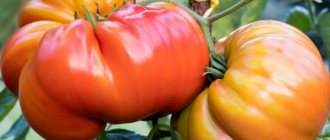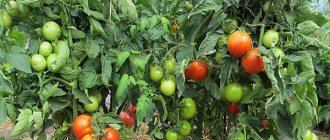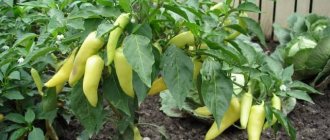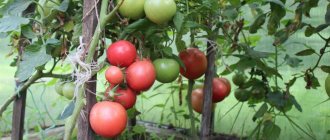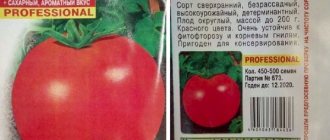Description and characteristics of the variety
The variety was included in the State Register of Breeding Achievements of the Russian Federation in 2007. It is intended for cultivation in open ground and under film cover.
- The variety has a 1st generation hybrid of the same name, “Crimson Giant F1,” which differs slightly in quality characteristics. Hybrids are always more resistant to changes in weather conditions and nightshade diseases, and also produce larger and tastier fruits. But hybrids need to be cared for more carefully and they have one big disadvantage - their seeds are unsuitable for sowing next season, since they do not retain varietal characteristics.
- Has an early ripening period. Ripe vegetables can be collected from bushes 105 days after seed germination.
- Determinate, it stops growing on its own, reaching a height of 120-150 cm, although the originator states that the bush does not grow higher than 90-100 cm. Read about indeterminate varieties here.
- Not standard, requires partial pinning. It is recommended to tie it to vertical trellises if there are large fruits.
- The root system is well developed, growing in all directions closer to the surface of the earth, not in depth.
- The leaves are dark green, large, standard in shape for tomatoes, without pubescence.
- The bushes are formed into 2 stems, excess side shoots are removed. To do this, pinch the stepson, leaving a 5 mm stump so as not to damage the main stems.
- The inflorescence is simple, intermediate. The first flower cluster is formed after 5-6 leaves, the subsequent ones - every 2 leaves. 6-8 fruits are formed on each brush.
- The articulated stalk perfectly holds large fruits.
- Moderately resistant to nightshade diseases such as Alternaria, Fusarium and Verticillium. It is not affected by late blight, since the crop is harvested before temperature changes begin.
- The variety is suitable for cultivation in open ground, in a greenhouse and under film cover.
- High yield - 1 course gives 4 kg of ripe vegetables or more, per 1 sq. meters, 8-12 kg of crop are harvested.
- Planting pattern 50 x 40cm.
Advantages and disadvantages, features and differences from other varieties
The Raspberry Giant tomato is a typical representative of large-fruited salad varieties. In general, the word “giant” is often found in the names of various fruit crops, including tomatoes. It must mean that the fruits are very different in size from many others. In the present case, this is not entirely true: there are a lot of large-fruited tomatoes with a fruit weight of 200–300 g, and their creators did not at all aim at the term distinguishing the variety from similar ones. Of course, the Crimson Giant has many advantages, for example:
- early maturation;
- excellent taste;
- nice coloring;
- resistance to diseases and pests;
- the possibility of growing both in open ground and in film greenhouses in all regions;
- ability of the crop to be transported and stored;
- Possibility of use in all types, except for whole-fruit canning, including in dietary nutrition.
Fruit characteristics
- The fruits of the Raspberry Giant tomato variety weigh differently. Usually, tomatoes up to 400 g grow at the bottom of the bush; smaller tomatoes form on the upper branches.
- The shape is round, well flattened at the stalk and tip. There is slight ribbing. Often tomatoes of this variety have the correct shape.
- Do not crack.
- Inside there are 4 or more seed chambers containing few seeds.
- The skin is thin and dense.
- Ripe tomatoes pink or raspberry color.
- The pulp is fleshy, juicy, medium density.
Important! Tomato seeds are small, like most large-fruited varieties.
- The concentration of dry matter is below average.
- Tomatoes have good keeping quality.
- Resistant to long-distance transportation.
- The taste of the tomato is sweet with a slight sourness.
- They do not cause allergies, so they can be included in dietary and baby food.
Interesting! Pink tomatoes contain more nutrients than red ones.
Description of the Raspberry Giant tomato
A review of the Raspberry Giant tomato, characteristics and description of the variety should begin with the fact that the crop has a hybrid of the same name. Its brother “Crimson Giant F1” has better characteristics. The varietal crop is slightly inferior in size and taste of the fruit, and in its tolerance to poor conditions.
The variety belongs to the determinate group of tomatoes. The bushes are not standard, but they do without the mandatory procedure of pinching the top. The root of the tomato is powerful, grows strongly on the sides, but does not go deep. The foliage shape is classic, like all tomatoes. The leaf blade is dark green. There are faint wrinkles on the surface of the leaf; there is no edge. The tomato bush is growing large. The stems are thick, strong, densely covered with foliage. Depending on the growing conditions, the height of the plant varies from 0.5 to 1 m. The average height of a tomato is 0.7 m.
The Raspberry Giant tomato bush forms simple inflorescences. It can grow up to 8 flowers, but they are not removed. According to the timing of the harvest, the variety is considered early. The fruits are borne in fan-type clusters. Up to 12 of them can form on one bush. The fruits practically do not crack and are firmly held on the stalk.
The video provides an overview of the Crimson Giant:
Description of fruits
Reviews and photos about the Raspberry Giant tomato confirm that the variety is large-fruited. The amount of clusters formed depends on the method of forming the bush: 1 or 2 stems. The fruits grow in a round, flattened shape. There is slight ribbing on the walls of the stalk. Each cluster produces tomatoes of approximately the same size. On average, the fruit weighs 200-400 g.
Important! You can grow larger fruits weighing up to 500 g, but to do this you will have to adjust the number of flowers and increase fertilizing.
The skin of the fruit is thin but durable. The surface is shiny. The greens begin with a characteristic dark area near the stalk. When fully ripe, the tomato acquires a beautiful crimson color. The pulp is fleshy, moderately juicy. A tomato contains 4-8 seed chambers. The grains are small, there are few of them in the chambers. The taste of a ripe tomato is sweetish with a pleasant feeling of mild acidity.
Photo
Below are photos of the Raspberry Giant tomato variety .
Planting in open ground
When the threat of return frosts has passed, you can plant the seedlings in open ground:
- We plant seedlings in holes at a distance of at least 50 centimeters from each other. When planting, you can add fertilizer to the holes. The most suitable one is phosphorus-containing.
- The crimson giant definitely requires a garter. Take this into account when landing.
- We water our giants as needed, trying not to get it on the foliage. Water for irrigation must be warm (cold water causes plants to stop growing and the roots may rot). For convenience, you can organize drip irrigation.
- Plants need to be fed several times a season. Feeding stops 3-4 weeks before fruit ripening.
- Plants require partial pinching. A good solution would be to form bushes into two stems. Remove all lower leaves up to the first ovary.
- We tie the formed bushes with ropes made of cotton fabric 10-15 centimeters wide. Thin threads or stiff wire are not suitable - they injure the stem.
- We periodically loosen the soil to saturate it with oxygen. The heavier the soil, the deeper we loosen it. We do this carefully so as not to damage the roots of the plant.
Advantages and disadvantages
Raspberry giant tomatoes, like all others, have their advantages and disadvantages. The positive qualities of the variety include the following:
- early ripening of vegetables;
- tomatoes are large, juicy;
- they look beautiful, so they are suitable for sale;
- gives a rich harvest;
- has good immunity to diseases and changes in temperature conditions.
Among the shortcomings, only one can be noted - in extremely rare cases, the variety is susceptible to diseases.
Appearance of tomato
Tomatoes of the Raspberry Giant variety cannot be called very beautiful, despite their attractive coloring. The fact is that they do not have a strictly regular shape; they are not among the fruits “like in the picture.” On one bush there may be tomatoes that are more or less even, of varying sizes, of varying degrees of ribbing, with or without emerging cracking. But these will definitely be large tomatoes, with a color ranging from pink (in a not fully ripened tomato) to distinctly crimson.
The fruits of this variety have excellent coloring, but even with the tomatoes chosen “for the picture” it is difficult to find two identical, “chiseled” in shape
Features of cultivation
seeds of the Raspberry Giant variety are sown for seedlings in February, and the seedlings are transferred to open ground in mid-May. The optimal time for planting seeds is the end of March or the beginning of April.
Before sowing the seed, it must be disinfected. To do this, the seeds are placed in a weak solution of potassium permanganate for 2 hours. Next, they are washed with warm water and dried.
To speed up germination, it is recommended to treat the seeds with the growth stimulator Zircon.
Fertile soil for tomatoes is poured into a large container or box. You can buy it in a specialized store or prepare it yourself, using equal quantities of garden or turf soil and old humus. Water the soil and lightly compact it. The seeds are buried 2 cm, maintaining a distance between sowings of at least 2 cm.
Important! The soil must be at least 25 degrees.
The crops are watered with warm water, covered with glass or film and placed in a warm place. The film is removed when the seeds germinate. The boxes are moved to a bright place and watered as needed.
After the appearance of 2 true sheets, pick them into separate cups with a volume of 300-500 ml. This procedure is necessary for the development of the plant and its root system.
After picking, it is advisable to feed with mineral fertilizers.
7-10 days before transplanting to a permanent place, the seedlings are hardened off. It is taken out onto the street or balcony, at first for a short time, gradually increasing the time. At the end of June, the seedlings can be transplanted to a permanent location. By this time, the stems at the roots become bluish. Seedlings are planted at intervals of 50 cm from each other.
Fertilizer containing phosphorus is first added to each hole.
More information about growing tomatoes is described in the article: Technology of growing tomatoes. Secrets of planting and care
You might be interested in: How to properly plant tomatoes in a greenhouse: bush formation diagram, care features, photos and videos
Useful information: How to properly tie tomatoes in open ground: the best methods, step-by-step photo and video instructions
Transplanting seedlings and subsequent care
The seedlings are transplanted into a greenhouse or open ground 2 months after the first germination of the seeds, but 2 weeks before transplanting the seedlings are hardened off - for this purpose they are taken outside or into the greenhouse during the daytime. Final planting occurs in the second half of April (for greenhouses) or in May-June (for vegetable gardens).
The transplant is carried out as follows:
- Debris and weed roots are removed from the pre-dug area.
- Water the soil with boiling water and manganese solution.
- Holes are dug (up to 40 cm deep, 50 cm between holes).
- A small amount of sand and fertilizer (humus and superphosphate) are placed at the bottom of the hole.
- The bed is moistened.
- Plant seedlings 2 bushes per hole.
After planting, the entire bed is sprinkled with wood ash - this will repel parasites. Further care is extremely simple:
- Plants are tied up as soon as the stem begins to sag;
- Watered.
- The beds are being loosened.
- Remove weeds.
- Crowns are formed by removing excess growth.
See also How to plant tomato seeds for seedlings at home
With properly prepared soil and quality care, farmers can harvest the first ripened tomatoes within 3 months after planting.
Watering and fertilizing
The irrigation system is the same as for other tomato varieties - seedlings need to be irrigated only when the soil has dried out and started to crack. To do this, you need to use warm water, preferably pre-settled.
The first feeding is given to the seedlings 2 weeks after planting - they should take root properly. The first fertilizers should be mineral - they are dissolved in water for irrigation. Nitrogen complexes are occasionally added - this will help the bushes grow a strong crown.
The second feeding occurs 14 days after the first, but organic fertilizers are used for it: a solution of bird or cow manure with water. After this, the seedlings can be fertilized every 3 weeks, trying to alternate the type of fertilizer.
Expert opinion
Stanislav Pavlovich
Gardener with 17 years of experience and our expert
Ask a Question
Important! A day after watering, the soil must be loosened!
Garter and shaping
To form slender tomato bushes, they must be tied to wooden pegs as soon as the stem grows so large that it begins to bend. When gartering, it is better to use fabric treated with potassium permanganate; you cannot use wire or thread.
All lower leaves are torn off to protect the plant from parasites. Of the 2 planted stems, leave the main one and one stepson in the upper axil. Excess stepsons that have reached 10 cm are removed regularly in the evening and in cool weather.
Protection from diseases and insects
Raspberry Giant tomatoes are resistant to parasites and diseases, so they practically do not need to be sprayed with chemicals. However, seedlings are occasionally affected by the Colorado potato beetle and late blight. The best protection against possible damage to tomatoes is to treat their seeds and soil before planting.
Preventive treatment of plants consists of weekly spraying with a weak solution of manganese. If parasites have already infected the plants, then they need to be treated with herbicides that do not accumulate in the fruits. Insecticides can be applied to the soil in the fall to remove all fungal larvae and spores.
Application
The raspberry giant tomato variety is a salad variety and is suitable for dietary and baby food. Tomatoes are very tasty, so they are eaten fresh, added to salads, hot dishes and soups, and also frozen. Fruits do not lose their nutrients and vitamins after treatment with heat or cold. However, Raspberry giant tomatoes are not suitable for whole-fruit canning due to the fact that the tomatoes are large and do not fit into a jar. But they make delicious tomato paste, ketchups and sauces, as well as juices.
Watch the video! Tomato Raspberry giant
Harvesting and application
After 100 days, the first harvest can be harvested from the seedlings - due to the rapid ripening, tomatoes need to be picked daily, inspecting the bushes. The yield of the variety indicated in the register is 5.9 kg per 1 sq. m, but in practice farmers harvest up to 10-15 kg per 1 sq. m.
Green fruits ripen perfectly when already picked, lying in the sun. Tomatoes are stored for up to 3 weeks in a dry, warm room in wooden boxes or transported for sale. Tomatoes are used to create salads, sauces, snacks and other preserves. They are combined for stews and lecho, they go well with bell peppers and eggplants.
Advantages and disadvantages
Gardeners love the crimson giant for:
- large fruits;
- precocity;
- good transportability and presentation;
- immunity to many diseases;
- relative ease of care;
- Possibility of use both fresh and prepared;
- a large number of useful substances and hypoallergenic.
However, the variety also has disadvantages:
- it is difficult to preserve whole tomatoes for the winter;
- large rhizomes take up a lot of space;
- although special care is not required, it is necessary to shape and plant the bush;
- Despite the declared resistance to almost all diseases, the most common of them can still affect the plant.
Diseases and possible pests
We have already said that a number of ailments are not terrible for this variety, but still there is no absolute resistance. Thus, like many other varieties, “Crimson Giant” can suffer from late blight, which is combated by adjusting the watering regime, loosening and the drug “Fitosporin”. Tomatoes are not protected from various types of rot, but it is often caused by excess moisture in the soil and the presence of a large number of weeds on the site. Accordingly, you must remove these factors; you can also use spraying with a manganese solution for prevention, and fight with calcium nitrate.
Pests also threaten the variety; it is important to deal with them in a timely manner. So, such products as “Confidor”, “Bison”, “Prestige” can be of great help against the Colorado potato beetle, aphids, and butterflies. At the first sign of defeat, you should actively begin the fight. Overnight, the same beetle can easily destroy one bush of newly planted seedlings.
Now there are many different drugs on sale labeled “Bio”. Choose them whenever possible, as they are safer.
Features of planting and growing
The Raspberry Giant tomato (the description of the variety and photos clearly demonstrate the large size of its fruits) must be grown in seedlings. Before the event, you will need to prepare the substrate and planting containers. In the future, you need to provide the seedlings with proper care.
Preparatory stage
Sowing should begin at the end of March - beginning of April. For the event, you need to prepare a small, shared container, since tomatoes develop better when picked. It is advisable to use special containers designed for growing seedlings. But any food containers with a height of up to 10 cm will do. But drainage holes should be made in them.
You need to sow tomato seeds in a universal mixture, which is sold in flower shops marked “For growing seedlings.”
You can make the substrate yourself by combining the following components in equal parts:
- turf land;
- sand;
- high peat;
- compost.
Sterilizing soil in the oven
Sterilization of soil with potassium permanganate.
Pests and pathogens that can destroy seedlings can live in the home substrate.
And to prevent this from happening, the mixture must be sterilized in any way:
- Disinfection in the oven. Spread the substrate over the surface of the baking sheet in a layer up to 5 cm thick. Pour hot water over the soil and place in an oven heated to +90 °C. Treat the substrate for 35-45 minutes.
- Steam sterilization. Place the mixture in a sieve lined with gauze or cloth and place on a bucket (pan) of boiling water. Cover the mixture with a lid and disinfect it for 80-90 minutes. Stir the mixture every 10-15 minutes for uniform sterilization.
- Disinfection with potassium permanganate. Dissolve the crystals in warm water, using 3 g per 10 liters. Pour the solution over the mixture so that the liquid completely covers it. After 30 min. Place the mixture on a sieve to drain excess moisture.
Disinfecting seeds before sowing is the key to healthy plant growth.
Seeds should also be treated. They need to be soaked for 8-10 hours in any growth stimulant (Zircon, Heteroauxin, Epin). If planting material is collected from a previous harvest, then it should be kept in a solution of potassium permanganate or fungicide (Fitosporin, Maxim, Vitaros) for 30 minutes. Store-bought seeds do not need such treatment.
Sowing
You need to sow tomatoes according to the following instructions:
- Sprinkle the bottom of the planting container with a layer of sand, expanded clay or crushed polystyrene foam (1 cm). Fill the container with substrate, leaving a gap of 2 cm from the edge.
- Level the surface of the soil, water it with warm water and draw grooves in it with a pencil up to 1.5 cm deep.
- Distribute the seeds into the depressions, maintaining a distance of 3-4 cm between them.
- Sprinkle the grains with soil. Its layer should not exceed 1 cm in height.
- Cover the container with a lid (film, glass) and place in a shaded place.
Near the crops, maintain the temperature within +22…+25 °C. Ventilate the planting daily by removing the cover for 5-10 minutes. It is necessary to remove condensation from the walls when it appears, since high humidity leads to rotting of the seeds. If the soil dries out, you should spray it with warm water from a spray bottle.
Seedling care
In the process of growing seedlings, you must adhere to the following instructions:
- When the first shoots appear, remove the planting cover and place the container in a lighted place. Plants should not be exposed to direct sunlight from 12:00 to 15:00, and at this time it is better to shade them. In spring, the length of daylight is still insufficient, so in the morning and evening, in cloudy weather, it is worth illuminating the seedlings with a phytolamp.
- It is necessary to water the plants when the top layer of soil dries out. During the process, use only settled, filtered water with a temperature of +22…+25 °C. Pour it in so that moisture does not get on the stems and leaves.
- When 2 true leaves appear on the seedlings, plant them in individual containers with a volume of 500-700 ml. Suitable soil with the same composition as for sowing seeds.
- 2 weeks after picking, fertilize the seedlings with a liquid mineral complex with nitrogen. You can use a solution of azofoska, nitrophoska, “Potassium humate” or “Agricola for vegetables”. If the seedlings look healthy and strong, then feeding them is not necessary.
- 14-15 days before planting the plants in the garden, begin hardening them off. Take the seedlings to the balcony or garden and leave them in a shaded and windless place for 20-30 minutes. Carry out this procedure daily, increasing its duration by 30-40 minutes.
- 7 days before planting, spray the tomatoes with a solution of Ecogel or Epin. Growth stimulants will strengthen plants and prepare them for unfavorable open ground conditions.
3-5 days before the event, cut off the cotyledon leaves. It is also worth spraying the seedlings with Ridomil Gold to prevent pests.
Soil and planting algorithm
The Crimson Giant tomato, a photo of which is given in the article, should be planted in illuminated areas. According to the description, lowlands and places with close groundwater are not suitable for the culture.
When choosing a site, it is necessary to follow the rules of crop rotation. You cannot grow tomatoes in one place for 2 years in a row, or plant them after eggplants, peppers, or potatoes. The best predecessors for the crop are zucchini, beets, cabbage, and carrots.
It is advisable to prepare a bed for tomatoes in the fall, following these instructions:
- Dig the soil to a depth of 25-30 cm. Remove all plant debris, weeds, and debris from the site.
- Add to each square. m of soil, 10 liters of humus, 25 g of superphosphate, 100-150 ml of wood ash.
- In the spring, dig up the soil again and add 25 g of ammonium sulfate and 5 kg of compost. Loosen the soil and level it with a rake.
At least 20 days should pass between preparing the site and planting tomatoes. You can plant seedlings in the garden in the middle - end of May, when warm weather sets in and the risk of return frosts disappears. If the plants are grown in a greenhouse, then you can start the event in early May.
Landing must be carried out according to the following algorithm:
- 30-60 minutes before planting, water the plants generously. Dig holes for them with a depth of 25-30 cm. Keep an interval of 50 cm between the depressions. Immediately install supports or stretch a trellis near the holes.
- Remove the seedlings from the containers along with the earthen lump. If the seedlings were grown in plastic cups, then they can simply be cut. If the plants were planted in peat tablets, then this step should be skipped.
- Water the planting holes generously with warm water. When the moisture is absorbed, install the plants in them. Fill them well with water.
- Fill the voids with soil. It is important that the stems are buried down to the cotyledon leaves.
- Compact the surface of the bed with your hands and mulch with peat, straw or wood and sawdust.
Covering tomatoes with spunbond will protect them from frost.
If frost may return, then the planting should be covered with film or lutrasil. Also, each bush can be protected with plastic bottles with a cut bottom. It is worth removing the cover after 1-2 weeks, when the plants take root. During the first week, you should not water or feed tomatoes.
Trimming
The Raspberry Giant tomato variety is determinate, but tall. And the stems of the crop should be tied to supports, which will prevent them from breaking due to the wind or a bountiful harvest. During cultivation, it is advisable to tear off the lower leaves to improve aeration near the roots.
To form tomatoes of this variety you need 2 stems. You will need to start planting the plant 1-2 weeks after planting it in the garden. In the process, it is necessary to remove shoots with a length of 5-6 cm. Do not touch shorter stepsons, as they are difficult to distinguish from fruiting clusters.
You will need to carry out the procedure every 7-10 days, following these instructions:
- On the main stem, select the lower stepson growing under the first flower cluster.
- Tear off the remaining shoots that have reached a length of 5-7 cm with a sharp movement to the side. You can use a knife, but it must be sharp and sanitized.
- It is important to leave stumps from the cut stepsons. Moreover, their length should reach 1-3 cm. Then a new shoot will not grow from this place.
The procedure should be carried out in the morning, before lunch. Then the damaged areas will heal faster and will not rot. Before trimming tomatoes, you should wear gloves. In the process, you will need to treat them with a solution of potassium permanganate or alcohol after each removed lash.
As the stems and shoots develop, they need to be tied to a support. In the process you need to use fabric strips or garden twine. You should also remove excess fruits in the clusters if there are more than 5 pieces. Such tomatoes will not ripen, but will take away nutrients.
Care
The Raspberry Giant tomato (the description of the variety and photos indicate its productivity) does not require much attention.
An example of correct and incorrect watering of tomatoes
But in order to collect a large number of fruits, it is important to carry out the following agrotechnical measures:
- Watering. The plant will need to be irrigated as the top layer of soil dries. And about 5-6 liters of water should be poured under each plant, and it is advisable to leave it for 24 hours and warm it in the sun to room temperature.
The procedure itself should be carried out early in the morning or at sunset so that the stems and leaves do not get burned. Pour water under the root, without getting on the ground part. When the first fruits begin to ripen, reduce watering and completely cancel it by August.
- Feeding. It is advisable to apply fertilizers to tomatoes several times a season: a week after planting, during flowering and bud formation, as well as during the period of mass fruiting.
An example of feeding tomatoes at different stages of their growth.
For feeding, it is better to use phosphorus-potassium mineral complexes. They need to be applied in liquid form, pouring under the root. For feeding, you need to choose a cloudy day, or carry it out in the morning.
- Loosening and weeding. After rainfall or watering, the soil under the tomatoes needs to be loosened, otherwise it will become compacted and the roots will not receive enough oxygen. During loosening, it is worth weeding the bed, removing weeds that can be carriers of diseases and pests.
- Mulching. Agrotechnical techniques make it easier to care for plants. Mulch retains moisture at the roots, prevents weeds and prevents the soil surface from compacting. But it is washed away along with watering and precipitation, so the layer must be renewed regularly. And to mulch tomatoes, you should use compost, grass clippings or straw, and sawdust.
- Hilling. To activate the growth of lateral roots and increase productivity, tomato bushes should be periodically hilled. The event will need to be held 2-3 times per season.
If tomatoes are planted in a greenhouse or greenhouse, then they need to be ventilated daily. On hot days, it is better to open the door to prevent the plant from overheating.
Diseases and pests
Tomatoes of the Raspberry Giant variety have good resistance to diseases characteristic of this crop.
But in unfavorable conditions they can be affected by the following diseases and pests:
| How to recognize | How to treat | |
| Late blight | The disease is most often transmitted through contaminated soil, and develops with frequent temperature changes and high air humidity. At the first symptoms, dark spots with a white border form on the leaves. On the reverse side, the lesions are covered with a grayish coating. | At the first signs of the disease, remove all affected leaves. If the disease has spread to the stems, the bushes will need to be destroyed. Treat plants and soil with copper-containing preparations. As a folk remedy, you can spray the planting with a solution prepared from whey and water (1:1). |
| Colorado beetles | Large insects with a characteristic striped color. The beetles and their larvae feed on leaves and stems and can cause major crop loss. | If there are few insects, then it is better to collect them with your hands and dust the plants with wood ash, or spray them with tobacco solution. For a large colony, it is advisable to use the insecticides “Commander”, “Bombardir”, “Prestige”. |
| Thrips | Small bugs of gray, black or brown color. Tomatoes planted in a greenhouse are most often affected. Leave small white dots (puncture sites) on the leaves. From their vital activity, the plant becomes covered with a sooty black coating. | A small colony can be driven away with an infusion of marigolds or garlic. If there are a lot of pests, then it is better to use the insecticides “Fufanon”, “Aktellik”, “Karbofos”. |
| Aphids | Small insects that are brown, gray or green. They affect the stems and leaves of tomatoes and often accumulate on the shoots. | Among the folk remedies, tobacco, soap or ash solution helps. If there are a lot of pests, then it is worth using the insecticides “Ratibor” or “Proteus”. |
| Spider mites | Small pests that are difficult to notice with the naked eye. But their appearance is indicated by a thin sticky web that accumulates in the axils of the leaves. | To kill insects, you can spray the seedlings with an alcohol solution, infusion of garlic or onion. The insecticide "Karbofos" will help against a large colony. |
Wintering
Tomatoes are annual plants, and there is no need to arrange a winter hut for them.
Harvesting
Tomatoes of the Raspberry Giant variety ripen together by the middle - end of July. And for consumption or making juices, ketchup, they should be removed at full ripeness, when the fruits turn a bright crimson hue.
You should not leave tomatoes on the bushes too long, as they will acquire a loose, mealy consistency, and their taste will noticeably deteriorate. To prevent this from happening, you need to harvest the crop every 2-3 days.
Storage
Unripe fruits collected at the end of summer can be sent for storage. They ripen well and quickly at temperatures from +30 °C. But it is better to keep them in a dark, cool place with a temperature of + 3...+5 °C.
You can increase the keeping quality of tomatoes by using paper to line the box.
To increase the shelf life of the fruits, you need to place them side by side in boxes covered with paper. You can sprinkle the crop with straw, which will absorb excess moisture. But you will need to check the tomatoes daily and remove ripe and spoiled fruits.
Growing seedlings
Tomato plants are grown from seedlings, so they will be stronger, develop better and get sick less, but here you need to be careful and follow certain requirements.
The seedling method allows you to grow heat-loving crops where summers are cold and short due to the growth spurt. But this does not affect the degree of disease resistance in any way. On the contrary, non-seedling tomatoes are stronger and more resistant to the vagaries of the weather.
Sowing seeds for seedlings
The variety does not tolerate much moisture
Starting from mid-March in the southern and middle zones of our country, you can begin the process of sowing seeds for seedlings. It is better to buy them in specialized agricultural stores or from trusted suppliers to avoid low-quality goods or counterfeits.
Before you send the seeds into the ground, they need to be prepared.
- Remove from the bag and soak in warm salted water for 15-20 minutes. Throw away the seeds that float immediately - they are dummies and will not germinate.
- Then leave them in a damp cloth or cotton cloth for 3 days until they hatch. Wet the napkin periodically.
- To harden the seeds, place them in the refrigerator for several hours.
- Prepare the soil for sowing: mix 2 parts of peat, 1 part of humus and 1 part of rotted sawdust, add wood ash or rubbed chalk at the rate of 500 g per 1 bucket of soil.
- Fill special containers with soil. Peat pots are better suited, from which seedlings do not need to be removed when transplanting into a greenhouse.
- Place the seeds in pots to a depth of 1.5-2 cm, pour a little water from a shallow watering can and sprinkle without compacting too much.
- Place the containers in a warm (22-25 ℃), well-lit place and cover the top with glass or transparent film to obtain a greenhouse effect. Remove it as soon as the first shoots appear.
Seedling care
When the first shoots appear, give them access to fresh air - place them on the windowsill (protect from direct sunlight). When 2-3 true leaves are formed on the stem, the seedlings are picked - each plant is transplanted into a separate pot, trying not to damage the not yet fully formed root.
A budget option is simple plastic glasses. 2 weeks after the sprouts emerge, fertilizer should be applied, but do not overdo it, so as not to burn the seedlings. Solutions of urea, ammonium sulfate, and ammonium nitrate would be suitable.
Water the seedlings infrequently, according to need and strictly at the root - the variety does not like a lot of moisture. The room temperature should be 18-22°; if it is higher, the seedlings will begin to stretch.
